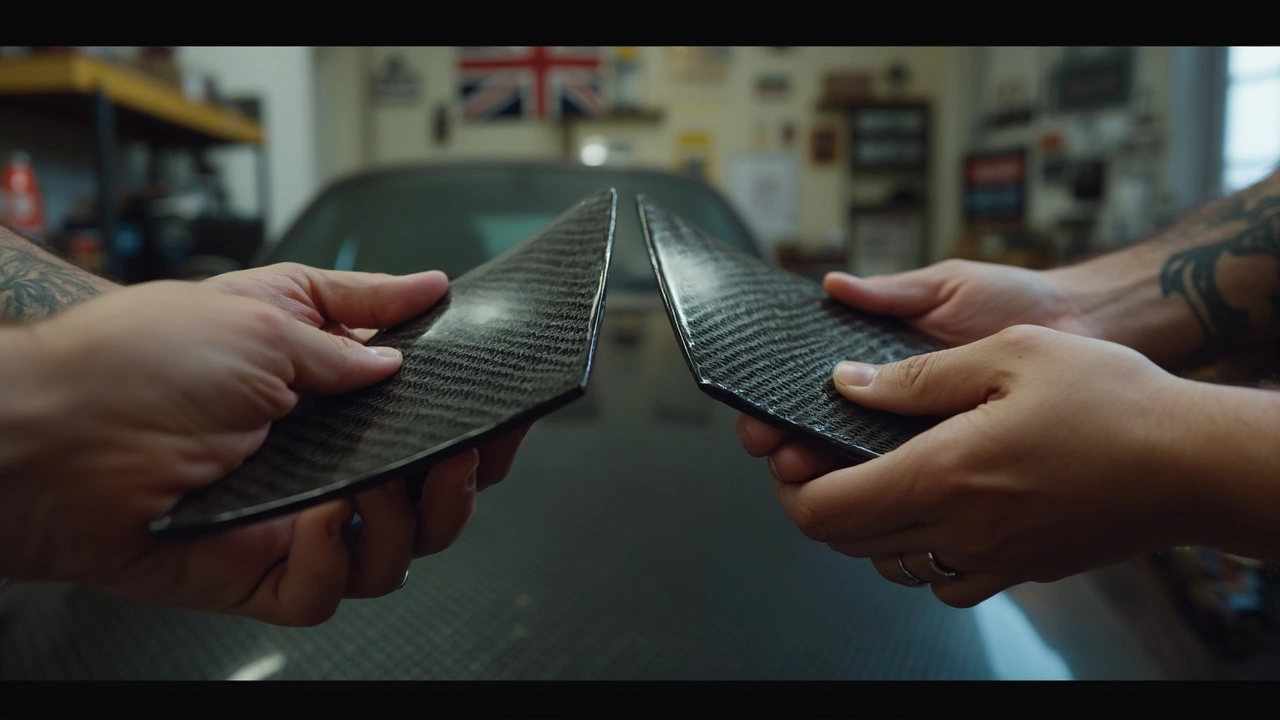Ever picked up a carbon fiber spoiler and wondered if that glossy weave is actually the real deal? You’re not alone. With so many fake carbon fiber parts flooding the market, it’s easy to get fooled—and it’s not just about looks. Real carbon fiber isn’t cheap, and you want performance, not just style.
Here’s the kicker: fake carbon fiber often looks almost perfect to the untrained eye, but there are dead giveaways if you know where to look. Forget about just trusting your local shop or a flashy online listing. If you want to make sure your money’s buying the genuine stuff, you need to know what real carbon fiber actually feels like, how much it should weigh, and where most sellers cut corners.
Get ready to spot the difference for yourself—before your next spoiler costs you more than it should.
- Spotting Real Carbon Fiber by Sight
- The Weight and Strength Test
- Price Tags: Highs and Lows
- Clues in the Manufacturing Details
- Simple Tricks for Buyers
Spotting Real Carbon Fiber by Sight
Looks can trick you, but real carbon fiber has a few signature tells. First, check out the weave. Genuine carbon fiber usually has a perfect, uniform pattern—each little square or herringbone strip is lined up without random shifting or jagged lines. Anything off, like messy alignment or odd spacing, usually points to a printed fake or a fiberglass part wrapped with a carbon-look film.
Flip the piece over if possible. Real carbon fiber spoilers often reveal the actual carbon layers at the edge or on the back. The inside should show a similar woven texture, not a rough matte plastic or a single layer that looks printed or clearly stuck on. Sometimes fakes just have one thin carbon-fiber skin glued to a plastic shell. If you only see the pretty pattern on top but totally different material underneath, that’s a red flag.
Lighting can help, too. When you tilt genuine carbon fiber in the light, the weave pops with a slight depth and shimmer that printed graphics can’t imitate. Printed carbon or hydro-dipped plastic rarely “sparkles”; instead, the pattern may blur, or you’ll notice pixels or stretching if you look really close.
Pay attention to the edges and corners. Real carbon fiber doesn’t peel away or show bubbles at sharp angles. Fakes, especially vinyl wraps, start to bubble or lift where the surface curves or bends tightly. Any sign of peeling means you’re not looking at the real thing.
Finally, give it a tap. Real carbon fiber material has a crisp, glassy tap—sort of like tapping thick plastic, but stiffer and less hollow. Fake carbon or plastics usually thud or sound dull. Combine all these checks, and you’ll massively improve your odds of picking out a carbon fiber spoiler that’s the real deal.
The Weight and Strength Test
Here's the deal—real carbon fiber is strong but crazy light. That's one of the big reasons gearheads pay top dollar for it. Most fakes are just plastic parts with a carbon-look sticker or a fiberglass knockoff. These cheap copies aren't nearly as light, and they definitely can't match carbon fiber's strength.
If you’ve got a genuine carbon fiber spoiler, it'll feel surprisingly light when you pick it up. For reference, a typical full carbon fiber car spoiler (around 4 feet wide) weighs just about 3 to 5 pounds (1.4 to 2.3 kg). Compare that to a fiberglass version, which usually tips the scale at 7 to 10 pounds (3.2 to 4.5 kg), or a plastic one, sometimes even more. That's almost double the weight for the same size.
| Material | Typical Weight (4 ft spoiler) | Strength |
|---|---|---|
| Carbon Fiber | 3-5 lbs (1.4-2.3 kg) | Extremely high (can support 10x its weight) |
| Fiberglass | 7-10 lbs (3.2-4.5 kg) | Decent, but more flexible |
| Plastic (ABS, etc.) | 8-12 lbs (3.6-5.4 kg) | Low, bends or chips easily |
Try this: gently twist or press the piece. Real carbon fiber shouldn't flex much at all. It's stiff, and even pushing hard, you'll barely get it to move. Fakes—especially those with plastic or fiberglass cores—flex easily.
Also, tap it lightly with your knuckle. A true carbon fiber part gives off a crisp, high-pitched sound, almost like tapping thick glass or ceramic. If it sounds dull or hollow like cheap plastic, you’re probably not holding the real thing.
Keep in mind, strength and weight are the main reasons pro racers and OEMs use carbon fiber. If your spoiler seems almost too light for its size, and refuses to flex under pressure, you're very likely looking at the real thing. Always compare weights when you can—and remember, if it feels like a chunk, it's probably a fake.

Price Tags: Highs and Lows
If you see a carbon fiber spoiler going for the price of a decent dinner, something’s fishy. Real carbon fiber is expensive to make, so no legit seller will offer a bargain-bin price for genuine stuff. Most of the time, when you see spoilers that look like carbon fiber but cost way less, they’re made with fiberglass or plastic, with a carbon fiber style wrap slapped on top.
Here’s what usually drives the cost up for real carbon fiber:
- Raw materials are pricey. High-quality carbon fiber sheet isn’t cheap to source.
- The molding process is labor-intensive. Real carbon needs careful hand layup, curing, and trimming.
- Genuine spoilers are much lighter and stronger, and that type of performance costs money.
If you’re shopping new, expect to pay anywhere from $400 to $2,000 (or more) for a real deal spoiler, depending on the car, the brand, and the complexity. Fakes can run as low as $80 and usually max out at around $250.
To make things clearer, check out this side-by-side:
| Type | Typical Price Range (USD) | Main Material | Common Signs |
|---|---|---|---|
| Real Carbon Fiber | $400–$2,000+ | 100% Carbon Fiber | Light, strong, clear weave, expensive |
| Fake Carbon Fiber | $80–$250 | Fiberglass/plastic w/ wrap | Heavier, cheaper, "carbon" pattern may look printed |
Bottom line? If a deal sounds too good to be true, it usually is. Always compare prices across trusted sellers, and be suspicious of brands offering identical looking spoilers at wildly different prices.
Clues in the Manufacturing Details
If you want to separate real from fake, checking out the manufacturing details is huge. Here’s the trick: those small details give away what’s legit and what’s not. Start by flipping your spoiler over and having a look at the back. Authentic carbon fiber usually has a clean, weaved pattern all the way through—not just on the front or exposed areas. Fakes often have the real pattern only on one side, while the back looks rough, irregular, or has plain plastic or fiberglass underneath.
The joints and edges are another giveaway. On genuine carbon fiber spoilers, you’ll see crisp, tight seams and smooth lines. Most high-quality manufacturers will hide any joins or wrap the weave neatly around corners. If you’re seeing fraying, obvious glue lines, or the pattern doesn’t match up at the edges, you’re probably looking at a knock-off or a cheap overlay.
Check for a glossy, even finish, but also look out for more than just shine. Real carbon fiber parts are often coated with a clear UV-protectant resin that’s smooth but has a solid feel—like glass. Bad fakes might have a bumpy feel or uneven clear-coat that can chip or flake off over time.
- Look for labels or manufacturer marks: A lot of legit brands etch or label their parts somewhere discreet. No markings? That’s a red flag.
- Ask about the layup: Some dealers know how the spoiler was made. Real carbon fiber is usually hand-laid, not “dipped” or filmed.
- Inspect mounting points: Real ones often have integrated metal threads or reinforced mounting spots. Fakes skip this to save money.
If possible, get your hands on pictures or info from a trusted seller who shows the backside, mounting details, and even the packaging. Sometimes the way a product is boxed and protected says a lot about what’s inside. A legit carbon fiber spoiler comes well-packed to avoid any flex or cracks during shipping, while a fake might be tossed in a basic box with zero padding.

Simple Tricks for Buyers
When you’re ready to buy, don’t just trust a product listing or a sales pitch. A little detective work can save you from dropping cash on something that’s just carbon-look plastic. Let’s break down the best ways to spot the real stuff quickly, even if you’ve never handled it before.
- Keyword: carbon fiber — Always check the product description, but take it with a grain of salt, because "carbon fiber style" or "carbon look" means it’s probably fake.
- Ask for Proof: Real carbon fiber usually comes with a spec sheet or manufacturer’s certificate, especially from reputable brands. If the seller can’t show you any documentation, that’s a huge red flag.
- Look Inside: If you get the chance, check the inside of the spoiler or an edge. Real carbon fiber is woven through and through, so it’ll have the same patterned look all the way, not just a printed top layer with a plastic or fiberglass core.
- Light Test: Shine a flashlight at the weave. Real carbon fiber will reflect in a twill pattern and shimmer kind of metallic, because the fibers are real. Fakes usually look dull or just shiny like regular plastic.
- Tap It: Gently tap the part with a coin. Real carbon fiber makes a sharp, snappy sound, while plastic or fiberglass makes a dull thud.
Keep in mind, a brand-new real carbon fiber spoiler for a popular car isn’t going to be dirt cheap. Here’s what you can usually expect to pay, so you know if a deal is too good to be true:
| Type | Average Real Carbon Fiber Price | Average Fake/Plastic Price |
|---|---|---|
| Full carbon fiber spoiler | $400–$1,500 | $50–$200 |
| Carbon fiber-overlay spoiler | $150–$400 | $30–$100 |
If you’re ordering online, check for real customer photos—not brand pics—so you can see the backside and edges. Avoid sellers with generic or stock images only. If you’re buying from someone local, ask to inspect the part in person. A real carbon fiber spoiler feels cold to the touch in cool rooms, while fakes stay room temperature.
These tricks won’t turn you into an instant expert, but they’ll weed out obvious fakes so you can score a genuine piece and keep your ride looking sharp—without wasting your cash.




